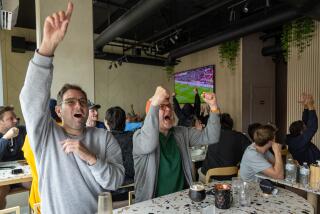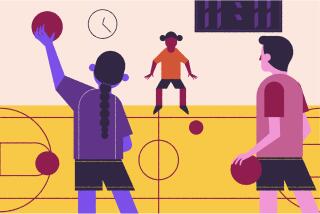Polo for the People : Commoners Take to Sport That Once Separated Hooves from Have-Nots
LAKE VIEW TERRACE — Patti Perez was simply looking for a place to rent a riding horse now and then. An avid rider, she soon found a suitable stable in Lake View Terrace.
But it was the hand-painted sign next to the stable that she found most intriguing.
“Polo Lessons,” it read.
Polo? No way. Too rich, too snobby, too expensive for me, Perez thought.
Then she thought again, and decided to plop down 25 bucks for a half-hour lesson (horse included). Then she took another. Now, four months later, the aircraft-parts purchaser is out every Saturday morning playing polo while all dressed up in traditional garb: white riding pants, kneepads and a protective helmet.
The foothills of east San Fernando Valley have long been among the last outposts in Los Angeles where working folks can own, rent and ride a horse. Now, the commoners have established their very own California Polo Club. And to fend off blue-blooded princes, they occasionally suit up in jeans and boots to play a crude game of “cowboy polo” with a beach ball.
“These are not snobby rich folks out here,” Perez said Saturday. “They are just normal people who love horses and love the thrill of the game.”
Perez, like her teammates, quickly found herself hooked after a few lessons.
With 22 members and 15 students, the club is one of two or three in the Southland solely dedicated to polo lessons and games.
“Polo has a bad rap,” said Bruce Gaither, one of the club’s founders and its most skilled player. “But it really is a perfect sport for anyone who loves horses and loves competition.”
The club was founded in November 1994 by Gaither and three friends who shared a love of polo but were tired of driving hundreds of miles to find a place to play. They rent a plot of land in Lake View Terrace, an affordable alternative to pricey private fields in Huntington Beach, Moorpark or San Diego.
*
On weekend mornings and weekday evenings, the group faithfully gathers to play games--composed of six periods called chukkers--followed by lessons for beginners.
Wanda Acuna has taken only three lessons, but she is already devoted to the sport.
“It is a very exciting game,” said Acuna, an actress who lives in Hollywood. “I like the speed and the high intensity of it. The danger is great.”
At its best, the sport combines well-honed riding skills and impeccable hand-eye coordination with the speed of true horsepower. Club players leave the arena dripping with sweat and often grinning broadly.
Bud Figliola, a vending machine manager from Manhattan Beach, had been on a horse just two or three times when he started taking lessons nine months ago. Now he competes against the club’s top players.
“I am living proof that anyone can do this,” Figliola said. “I just love it. In terms of being exciting, it’s on par with something like skydiving.”
*
In polo games, the team that scores the most points in 42 minutes of play wins.
Games are either indoor or outdoor, terms that refer to game variations, not to whether the event takes place in a building. Outdoor arenas are about three times bigger than indoor, and the games tend to be faster and more dangerous.
At the end of each chukker, especially during outdoor games, the world’s best players change their exhausted horses for fresh ones.
Such players own a personal stable or rent half a dozen horses per game, contributing to polo’s image as a wealthy person’s sport.
But things are different at California Polo Club, where only indoor polo is played and where players don’t change horses.
The club’s one-horse games are still dramatic, high-speed encounters.
“This is the ultimate stress reducer,” said club co-founder Ralph Rosato, wiping his brow after a match Saturday. “And it’s cheaper than therapy.”


